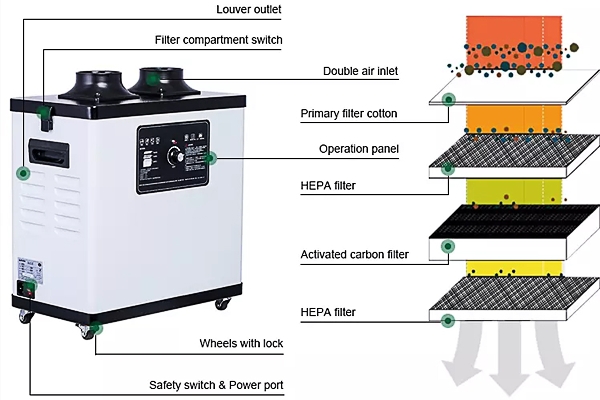How to Use a Fume Extractor?
Using a fume extractor is essential for maintaining a safe and healthy environment when dealing with fumes, smoke, or airborne particles in a workspace. Fume extractor systems are commonly used in soldering, welding, chemical laboratories, woodworking, and other environments where harmful substances may be present. Using a fume extractor is relatively straightforward, but the specific steps may vary depending on the model and type of fume extractor you have. Here is a general guide on how to use a fume extractor effectively.
Tips for Using the Fume Extractor
-
Read the User Manual: Before using the fume evacuator, thoroughly read the user manual provided by the manufacturer. The manual will contain essential safety information, operational guidelines, and specific instructions for your particular model.

-
Setup and Positioning: Place the fume extractor near the source of the fumes or pollutants. Ensure it is positioned as close as possible to the fume-emitting process or area for optimal capture. Some fume extractor systems come with adjustable arms or hoods that can be positioned directly above the source.
-
Power Connection: Ensure the ventilation hood is properly connected to a power source. Most fume extractors operate on standard electrical outlets, but some industrial models might require specific power connections.
-
Filter Inspection: Check the filters (such as high-efficiency filters and activated carbon filters) before use to ensure they are clean and in good condition. If the filters are dirty or damaged, replace them following the manufacturer's guidelines.
-
Switch on: Turn on the air purifier using the power switch or controls provided. Some models may have variable fan speeds or other adjustable settings. Choose the appropriate settings based on the level of fumes and the efficiency required.
-
Operation: As the fume extractor runs, it will draw in the contaminated air through the inlet or hood. The filters inside the extractor will capture and remove the harmful substances, and the purified air will be released back into the environment.
-
Monitoring: While the fume extractor device is running, monitor the air quality and the effectiveness of the extraction. Ensure that the fume extractor equipment is adequately capturing the fumes and pollutants. Adjust the positioning and settings if necessary to improve efficiency.
-
Shutdown: When you are done using the fume extractor unit, turn it off and disconnect it from the power source. If the fume extractor has a specific shutdown procedure (such as letting the fan run for a few minutes to clear any remaining fumes), follow the manufacturer's instructions.
-
Maintenance and Cleaning: Regularly clean the exterior of the fume extractor to remove any dust or debris. Additionally, follow the maintenance schedule provided by the manufacturer, which may involve periodic filter replacements and other upkeep tasks.
Important Notes
- Always ensure that the fume extractor is compatible with the type of fumes and pollutants you are dealing with.
- If the fume capture system is equipped with an exhaust system, make sure the exhaust is vented to a safe location away from occupied areas or recirculated through appropriate filtration.
- A fume extractor is designed to assist in creating a safe working environment, but it is not a substitute for proper ventilation and safety measures. Follow the appropriate safety protocols when dealing with hazardous fumes and substances.
- If you are unsure about how to use a specific fume extractor model, it is best to consult the manufacturer or a qualified technician for guidance and support. Proper use of a fume extractor contributes significantly to a safer working environment and helps prevent exposure to harmful fumes or particles.

